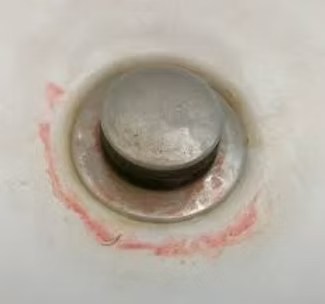A pinkish residue frequently shows up in bathrooms in many homes, especially around tile grout, shower curtains, and drains.
Although it could be mistaken for mold, the bacterium Serratia marcescens is the true cause of this discoloration.
This microbe feeds on fatty materials present in soap and shampoo residues and grows best in damp conditions.
This problem was brought to light by National Health Service (NHS) surgeon Dr. Karan Raj, who said: “If you’ve noticed this pink slime hiding in your bathroom, it’s not mold—it’s bacteria.”

He added that the reason Serratia marcescens prefers to stay around in the bathroom is because it “loves damp, moist places and enjoys munching on fatty deposits like those found in soaps and shampoos.”
Serratia marcescens is typically safe for healthy people, however it can be harmful to some groups of people.According to Infectious Disease Advisor, this bacterium “may be found in the corner of wet showers or wash basins, where it is visible due to the red-colored pigment (prodigiosin) it produces.” It can also be found in soil, water, plants, and animals.
Exposure can result in infections of the urinary tract, respiratory system, or wounds in those with weakened immune systems, such as hospitalized patients, the elderly, and people with long-term illnesses. Because the bacterium is resistant to several antibiotics, treating these infections can be difficult.
“You still want to avoid getting it in your eyes or open wounds,” cautions Dr. Raj. Additionally, he cautions that in addition to feeding Serratia marcescens, chronic toilet moisture can also promote the growth of other dangerous organisms like black mold, which poses serious threats to respiratory health.
Take into account the following precautions to reduce the possibility of mold and bacteria growing in bathrooms:
Maintain Appropriate Ventilation: To lower moisture levels, make sure bathrooms are adequately ventilated by opening windows or using exhaust fans before, during, and after showers.
Frequent Cleaning: Use disinfectants that contain hydrogen peroxide or bleach to clean bathroom surfaces on a regular basis. Pay attention to places that stay wet, like the grout in tiles, shower curtains, and the vicinity of sinks.
Deal with Leaks Right Away: Any plumbing leaks should be fixed right away to avoid water buildup, which can serve as a haven for mold and bacteria.
Reduce Clutter: To cut down on surfaces where bacteria might grow, store as few items as possible in the shower area.
By following these guidelines, homeowners may guarantee a healthier living space by drastically lowering the amount of Serratia marcescens and other dangerous germs in their bathrooms.
The lesson learned? The bacterium Serratia marcescens, not mold, is the cause of the pink residue frequently seen in toilets. It can cause serious infections in those with compromised immune systems, but it offers little risk to healthy people.
You can stop it from growing and protect yourself from any health risks as long as you keep your bathroom dry and clean.Were you aware of the possible risks associated with pink slime?






